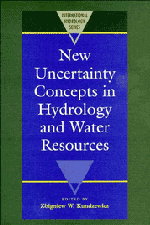Book contents
- Frontmatter
- Contents
- List of Authors
- Preface
- I INTRODUCTION
- II FACETS OF UNCERTAINTY
- 1 Bayesian relative information measure – a tool for analyzing the outputs of general circulation models
- 2 A stochastic weather generator using atmospheric circulation patterns and its use to evaluate climate change effects
- 3 Hydrological uncertainty – floods of Lake Eyre
- 4 Some aspects of hydrological design under non-stationarity
- 5 New plotting position rule for flood records considering historical data and palaeologic information
- III NOVEL APPROACHES TO UNCERTAINTY: FRACTALS, FUZZY SETS AND PATTERN RECOGNITION, NON-PARAMETRIC METHODS
- IV RANDOM FIELDS
- V TIME SERIES AND STOCHASTIC PROCESSES
- VI RISK, RELIABILITY AND RELATED CRITERIA
1 - Bayesian relative information measure – a tool for analyzing the outputs of general circulation models
Published online by Cambridge University Press: 07 May 2010
- Frontmatter
- Contents
- List of Authors
- Preface
- I INTRODUCTION
- II FACETS OF UNCERTAINTY
- 1 Bayesian relative information measure – a tool for analyzing the outputs of general circulation models
- 2 A stochastic weather generator using atmospheric circulation patterns and its use to evaluate climate change effects
- 3 Hydrological uncertainty – floods of Lake Eyre
- 4 Some aspects of hydrological design under non-stationarity
- 5 New plotting position rule for flood records considering historical data and palaeologic information
- III NOVEL APPROACHES TO UNCERTAINTY: FRACTALS, FUZZY SETS AND PATTERN RECOGNITION, NON-PARAMETRIC METHODS
- IV RANDOM FIELDS
- V TIME SERIES AND STOCHASTIC PROCESSES
- VI RISK, RELIABILITY AND RELATED CRITERIA
Summary
ABSTRACT Mathematical models that generate scenarios containing no temporal correspondence to time series of actual occurrences are difficult to evaluate. One such class of models consists of atmospheric General Circulation Models (GCM), which have an additional drawback that the temporal and spatial scales of their outputs do not match those of the actual observations of the simulated phenomena. The problem of disparate scales can be ameliorated by aggregating both the model output and the observed data to commensurate scales. However, this approach does not permit quantitative testing at scales less than the least common level of aggregation.
The lack of paired observations in the aggregated time series makes standard statistical methods either invalid or ineffective in testing the validity of a GCM. One approach to resolving this quandary is the use of a relative information measure, which is based on the uncertainties contained in the histograms of the aggregations of both the model output and the data base. Each interval of each histogram is analyzed, from a Bayesian perspective, as a binomial probability. For the data-based histogram, the reciprocal of the sum of the variances of the posterior distributions of probability in each interval is denoted as its information content. For the model-based histogram, the reciprocal of the sum of the expected mean squared errors of the posterior distributions in each interval likewise is its information content.
- Type
- Chapter
- Information
- Publisher: Cambridge University PressPrint publication year: 1995

